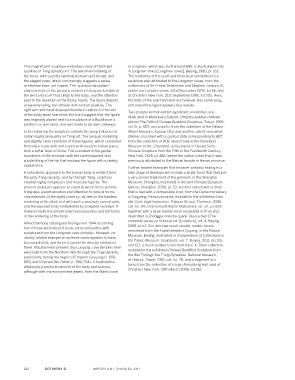Page 144 - Important Chinese Art Sothebys March 2019
P. 144
this magnificent sculpture embodies many of the finest in Longmen, which was built around 680, is illustrated in situ
qualities of tang dynasty art. the sensitive modeling of in Longmen shiku [Longmen caves], Beijing, 1980, pl. 162.
the torso, with a gently swelling stomach and breast, and the rendering of the scarf and torso bear similarities to a
the elegant pose, which convincingly suggests a sense sculpture also attributed to the Longmen caves, from the
of ethereal ease, are superb. the ‘spiritual naturalism’ collections of sir ernest Debenham and stephen Junkunc III,
characteristic of the period is evident in the graceful folds of sold in our London rooms, 22nd november 1946, lot 56, and
the skirt and scarf that clings to the body, and the attention at Christie’s new York, 21st september 1995, lot 302. here,
paid to the depiction of the fleshy hands. the figure depicts the folds of the scarf and skirt are however less convincing,
a heavenly being, but imbued with human qualities. the and overall the figure appears less stately.
right arm and hand disproportionate in relation to the rest two sculptures that exhibit significant similarities, are
of the body when seen from the front suggest that the figure illustrated in matsubara saburō, Chūgoku bukkyō chōkoku
was originally placed next to a sculpture of a Buddha on a shiron/The Path of Chinese Buddhist Sculpture, tokyo, 1995,
platform or wall niche, and was made to be seen sideways.
vol. III, p. 603, nos a and b, from the collection of the nelson
In its rendering the sculpture exhibits the deep influence of atkins museum, Kansas City; and another, albeit somewhat
Indian Gupta sensuality on tang art. the sensual modelling sterner, inscribed with a cyclical date corresponding to 687,
and slightly stern character of these figures, which combined from the collection of W.r. hearst now in the Cleveland
hellenistic traits with north and north-western Indian styles, museum of art, Cleveland, is illustrated in osvald sirén,
took a softer tone in China. this is evident in the gentle Chinese Sculpture from the Fifth to the Fourteenth Century,
roundness of the stomach with the navel exposed, and new York, 1925, pl. 482, where the author notes that it was
subtle tilting of the hip that endows the figure with a stately previously attributed to the Baimai temple in henan province.
appearance.
Further related examples that however possibly belong to a
a naturalistic approach to the human body is evident from later stage of development include a larger torso that features
the early tang dynasty, and by the high tang, sculptors a very similar treatment of the garment, in the shanghai
created highly voluptuous and muscular figures. the museum, shanghai, illustrated in Ancient Chinese Sculpture
present sculpture appears to stand between these periods. Gallery, shanghai, 2000, pl. 23; another carved with a dhoti
It displays a sophistication and attention to natural forms that is tied with a comparable knot, from the Dahai monastery
characteristic of the eighth century, as seen in the flawless in Xingyang, henan province, included in the exhibition Cina
rendering of the dhoti tied with such a precisely carved sash, alla Corte degli Imperatori, palazzo strozzi, Florence, 2008,
and the exposed body embellished by a beaded necklace. It cat. no. 34; a torso illustrated in matsubara, op. cit., pl. 693,
however lacks the unrestrained sensuousness and full forms together with a large marble torso excavated in Xi’an and
in the rendering of the torso. illustrated in Zhongguo meishu quanji. Diaosu bian [the
complete series on Chinese art. sculpture], vol. 4, Beijing,
alfred salmony catalogued this figure in 1944 as coming
from henan and indeed it bears some similarities with 1988, pl. 53. see also two much smaller marble torsos,
sculptures from the Longmen cave complex. however, no recovered from the Xiude temple in Quyang, in the palace
museum, Beijing, illustrated in Compendium of Collections in
closely related example from these caves appears to have the Palace Museum. Sculptures, vol. 7, Beijing, 2011, pls 126
been published, and hence it cannot be directly attributed
there. situated near present-day Luoyang, cave temples here and 127; a much smaller torso from the C.K. Chan collection,
were built from the northern Wei through the tang dynasty, included in the exhibition Chinese Buddhist Sculpture from
the Wei Through the T’ang Dynasties, national museum
particularly during the reigns of emperor Gaozong (r. 650- of history, taipei, 1983, cat. no. 28; and a fragment of a
683) and empress Wu Zetian (r. 684-704). a bodhisattva
displaying a similar treatment of the body and scarves, torso from the collection of evelyn annenberg hall, sold at
although with more prominent jewels, from the Wanfo cave Christie’s new York, 29th march 2006, lot 182.
142 SOTHEBY’S Important ChInese art

